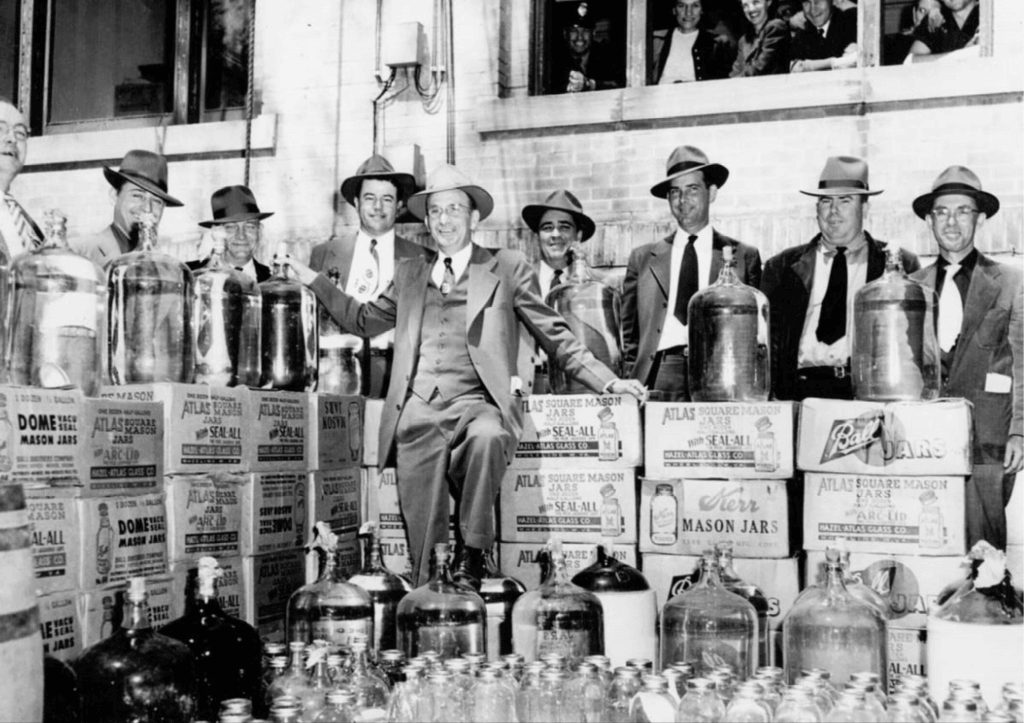National Moonshine Day
National Moonshine Day is observed next on Thursday, June 4th, 2026 (171 days from today).

National Moonshine Day is a celebration of the drink on the 5th of June every year that is considered as illegal in tradition.
Moonshine, once a fiery (and illegal) homemade alcohol, is now legal. However, the drink evokes colorful early 20th-century memories of Prohibition, speeding cars and makeshift still live in the Appalachian woods.
The drink gained legendary status after the 18th Amendment (Prohibition) was passed in 1919. At that time, Americans who wanted to drink had to go to the black market of the day, which belonged to the bad guys and smuggling. They distilled the moonshine and handed it over, making everyone involved feel guilty.
Today major distilleries sell moonshine, eager to rekindle nostalgic memories of the illegal drink. But the days of cheap, questionable beers with deadly contaminants are over.
Why National Moonshine Day?
People love infusions or craft cocktails and when we come to infusions; it tastes best when served with the right dose of moonshine. You can start the concoction with old moonshine, add some herbs to the mix, marinate just enough and enjoy the drink. When we talk about moonshine, the topic also unintentionally revolves around the looters of the time. It is a drink that has garnered many catchy names and captured the attention of liqueur lovers across the country. Songs have been written about this drink such as “Apple Pie Moonshine”, “Copper Kettle”, and more that has raised the popularity of this drink to a new level.
It's not just fun nicknames and moonshine backing songs that claim to pay tribute to this traditional liqueur. Moonshine is also a drink that reminds us of forbidden times and how grateful we need to be now to enjoy this and many other drinks without fear of prosecution right now. This is why we celebrate National Moonshine Day in support of this popular and traditional drink of smugglers.
History of National Moonshine Day
Moonshine also commonly known as white lightning, hooch, mountain dew, rotgut, fire water, skull pop, and Tennessee white whiskey is a high strength distilled spirits illegally produced in its truest form. It is usually about 150 proofs, or about 75% alcohol by volume. Even though it's illegal to make moonshine at home, we celebrate it anyway.
The name "moonshine" may have come from "moonrakers", a historical term for smugglers in England. "Moonshining" in the UK also means any work done at night. Americans may have used the term because the drink was made secretly or by the light of the moon. Early moonshiners were usually made with rye or barley, but since the 19th century almost all moonshine has been made with corn. A common recipe for it is cornstarch, sugar, yeast, and water. During Prohibition, white sugar was often used in place of cornstarch. Moonshine is clear because it is not aged in oak casks like whiskey. The aging process in the barrel also causes the whiskey to go away, and since moonshine doesn't use this process it has an impact on it. Some bad moonshine can be harmful to humans. In the past, some unsafe materials were sometimes added to create a bigger kick, which also made it dangerous.
Throughout history, moonshine has sometimes been made to avoid taxes, and sometimes to circumvent the outright ban on alcohol. In the US, moonshine was first produced in Pennsylvania and other states where grain was an important commodity. The leftover seeds from the harvest are distilled so that they are not wasted. In 1791, a tax on alcohol known as a "whiskey tax" was introduced in the United States. Three years later, the Whiskey Rebellion broke out in Pennsylvania and President Washington sent 13,000 troops to bring order. The tax was abolished in 1801.
Moonshining continued after the Whiskey Revolt and was popular in Kentucky, Virginia, the Carolinas, and in the Southern states. Wine is still often associated with the South today. The ban went into effect in 1920, which has really helped drinkers, who can no longer legally buy alcohol - their market has expanded considerably and there is more demand. But with the repeal of the Prohibition in 1933, demand dropped and continued to do so over the years. Nowadays moonshining is very rare. Some "moonshine" these days are sold in stores, and follow the same recipe as the loot, but are not illegal.
Prohibit
Distilling skills first came to the United States with the Scots-Irish people when they settled in Virginia.
Moderate laws and prohibitions were passed in several states before the Civil War, but it was not until the turn of the century that the moderate movement emerged. By the time the 18th Amendment was ratified in early 1919, more than half of the country was dry.
The ban lasted 13 years. It created a demand for the moon, unlike any that might have existed before. Moonshine became big business overnight.
Modern Moonshine
Today, the moon in the legal sense has one of the following. Small-scale distilleries are legally producing moonshine, giving moonshiners a new name. Take moonshine out of the woods and compare it with other whiskeys for a place on the shelf. Many people are packing their draft beer in canned jars, embracing their rich history, while experimenting with flavor and branching out by pairing similar foods to wine and beer.
Subsidiary information
- Shepherd is Uncle Jesse's CB handle on Dukes of Hazzard. Sweet Tillie is the name of his Ford LTD / Galaxie in the first episode - his moon runner.
- The X symbol on the moon tank represents the number of times a batch is run through the calm. If marked XXX, moonshine is pure alcohol.
- What do Esther Clark, Edna Giard, Stella Beloumant, Mary Wazeniak have in common? They are all looters. Bootlegging is an equal opportunity profession.
- Lavinia Gilman is also a scammer. At 80, she still drives a 300-gallon car in Montana. However, the judge suspects her son is the real culprit.
- During the ban, there were many ways to transport loot moonshine. Funeral tampering is a convenient way to move products. Of course, out of respect for the dead, the badge holders were reluctant to stop the funeral.
Interesting facts about National Moonshine Day
- There is a legit moonshine produced in this day and age, which has earned a different reputation for the drink itself.
- Many individuals are preparing and packaging their craft whiskey or their version of moonshine in canned jars, as they have captured the history. It also helps to experiment with different flavors and pairings with other drinks.
- There is an X drawn or printed on the vase with moonshine. It represents the number of times moonshine is distilled. When a decanter has XXX on the top, it means you're looking for the purest form of alcohol.
- Lavinia Gilman who is 80 years old from Montana is a smuggler. She has a bag with 300 gallons. When the charges were brought, the judge thought it was her nephew who was behind the behavior.
- During the Prohibition era, many creative ways were used by smugglers to transport whiskey, most commonly funerals. It was a convenient option because many authorities were hesitant about stopping a funeral march.
How to celebrate National Moonshine Day
- Try craft whiskey
Craft whiskeys are distilled by small companies as well as individuals. These whiskeys are produced in a non-mechanized manner. So if you want to feel like you're celebrating the successful days, a craft whiskey will bring you closer than drinking a big batch whiskey from one of the renowned distillers. We can't guarantee your craft whiskey comes from someone's backyard cask, but we can't guarantee it doesn't either.
- Watch a NASCAR race
The origins of NASCAR are filled with stories of scammers carrying moonshine in their well-stocked cars, fleeing the authorities. As demand for bootleggers dwindled, drivers needed a way to show off their fast cars. They eventually started racing on the local back roads, and then on the dirt ovals. NASCAR was born. Historians note that North Carolina's auto racing tradition developed in smugglers' garages, especially on the roads between North Wilkesboro and Charlotte. Today's NASCAR is nothing like the early days of back roads and smugglers, but neither is whiskey like the risk of moonshine blindness. Both are good things.
- Working under the moonlight
Want to feel the difficulty of making the moon? Moonshine makers must work in the shadows to help them evade the authorities. Moonlight is their only guide. So you can try doing an outdoor chore just under the moonlight. (Preferably something that doesn't involve fast-moving blades or working on ladders - safety, after all.)
Why we love National Moonshine Day
- Infusion
Craft cocktails are all the rage right now, and many of them call for pickles. The best way to make your own is to start with some good old fashioned moonshine, then just pick your mix - herbs are a great choice - and let them marinate. You may not be making your own wine, but the spirit is there!
- "Whiskey Cooling"
The creators of moonshine are a creative type, they come up with cool nicknames and songs to honor their way of life. Songs like "Copper Kettle" and "Apple Pie Moonshine" helped create and highlight the legend of the sneaks and make the 'shine'. Then there are the nicknames for the alcohol – skull beer, white lightning, mule rock, and radiator whiskey, among other things. Ad agency miners have a hard time keeping up with the creativity of profit miners.
- Era (or bug?) of Prohibition
Now that we live more and more in an age of recreational marijuana use, Prohibition seems downright weird. (This is the only amendment to the Constitution ever repealed.) The existence of moonshine reminds us gratefully that we live in a country where we are allowed certain freedoms (anyway at this point).
Observed
National Moonshine Day has been observed the first Thursday in June.Dates
Thursday, June 6th, 2024
Thursday, June 5th, 2025
Thursday, June 4th, 2026
Thursday, June 3rd, 2027
Thursday, June 1st, 2028


